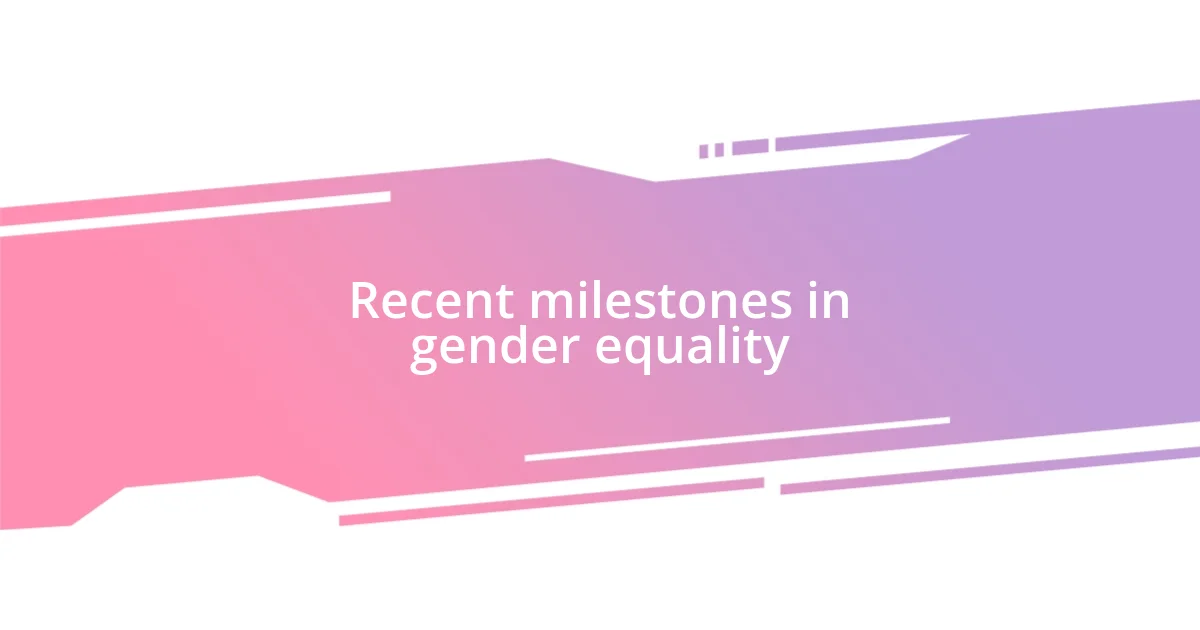Key takeaways:
- Significant progress in Olympic gender equality with near-equal participation of women, highlighted by nearly 49% female athletes at Tokyo 2020.
- Historical milestones, such as the introduction of women’s events and the establishment of mixed-gender competitions, reflect ongoing strides toward equality.
- Future challenges include financial disparities, cultural attitudes, and the need for increased representation of women in leadership roles within sports organizations.

Overview of Olympic gender equality
Gender equality in the Olympics has seen significant strides over the years, with women now participating in almost every event. I remember watching the Olympics as a child and often wondered why there were so few female athletes showcased in prime time. It felt disheartening, but today, it’s inspiring to see female athletes not only being featured prominently but also breaking records and winning medals.
The introduction of new events specifically for women, such as the addition of ski jumping and the introduction of a women’s competition in boxing, has pushed the envelope further. But, isn’t it worth asking why it took so long for these opportunities to emerge? Reflecting on this, I find myself appreciating the journey—every achievement teaches us the value of persistence and determination in the face of unequal treatment.
Despite these advances, challenges remain. For instance, why do some sports still see disparities in funding and media coverage for women compared to their male counterparts? As I follow these developments, it’s clear that while we’ve made progress, the conversation needs to continue—there’s still much work to be done to ensure that female athletes receive the respect and recognition they deserve.

Historical context of gender issues
Throughout history, the Olympic Games have reflected societal views on gender, often sidelining women. When I think back to the early days of the Olympics, it’s striking to realize that women were only allowed to compete in a limited number of events, if at all. For instance, it wasn’t until 1900 that women made their Olympic debut in Paris, participating in just sailing and croquet. This feels so archaic now, especially when you consider that their capabilities have always been vast and varied.
- 1900: Women first allowed to compete in the Olympics.
- 1928: Women’s track and field events introduced.
- 1964: Judo included for men, but women’s judo didn’t appear until 1992.
- 1984: The first Olympics to include a full slate of women’s events.
- Present: Nearly equal participation, with women competing in most events.
Reflecting on this history, I can’t help but feel a mix of hope and frustration. It’s remarkable how far we’ve come, but also disheartening to recall the many years women were denied rightful opportunities. As I immerse myself in this timeline, I recognize that every leap forward has been fueled by the tireless efforts of those advocating for equality. Their stories of resilience resonate deeply with me and remind me of the continuing battle for full recognition and respect within the sporting community.

Recent milestones in gender equality
It’s heartening to see the International Olympic Committee (IOC) making commitments to gender equality. For example, the Tokyo 2020 Games prioritized gender representation, resulting in the most balanced Olympic lineup to date, with women comprising nearly 49% of the athletes. I remember feeling a rush of pride as I watched events where female athletes thrived on equal footing, showcasing their remarkable talents and determination. It’s moments like these that serve as powerful reminders of how far we’ve come and the importance of representation in inspiring the next generation.
In addition to the impressive athlete participation, the introduction of gender parity in events has been crucial. The IOC has worked to include a variety of mixed-gender events, like mixed relay races in athletics and swimming. Witnessing these events made me reflect on how they challenge outdated notions of gender roles in sports. Ultimately, it’s invigorating to see both men and women competing together, fostering a sense of unity and shared achievement. I often find myself thinking about how these changes will influence young athletes who dream of competing on the world stage, empowering them to believe that their gender will not define their capabilities.
Furthermore, as we celebrate these milestones, it’s essential to acknowledge the role of media in shaping perceptions of female athletes. Increased coverage of women’s events is gradually shifting the narrative, offering a more balanced view that recognizes their achievements. I often think about how invaluable this representation is for young girls watching at home—seeing role models who look like them competing and excelling can truly ignite dreams. As I reflect on recent strides, I remain optimistic that this shift will continue and inspire more equitable opportunities for all athletes in the future.
| Year | Milestone |
|---|---|
| 2021 | Tokyo 2020 Games showcased nearly 49% female athletes. |
| 2020 | Mixed gender events introduced, enhancing competition dynamics. |
| 2019 | IOC enforced gender equality in all Olympic sports by 2024. |

Analysis of current policies
Analyzing current policies, I see a complex landscape shaped by ongoing debates about gender equality in sports. The IOC’s commitment to achieving gender parity by 2024 is a significant step forward. Yet, I often wonder how these lofty goals will translate into actual changes on the ground. Can policies truly shift cultural perceptions, or are they merely band-aid solutions? From my perspective, it’s essential that these policies are not only implemented but followed through with sustained support and funding.
Furthermore, policies aimed at gender equality need to go beyond just numbers. For me, it’s not just about having women compete in equal events; it’s about ensuring they have the same training resources and media exposure that their male counterparts enjoy. I recall attending a local sports event where a male athlete was celebrated for his achievements, while the female athletes were barely acknowledged. This disparity struck me as deeply unfair. How can we inspire young girls if we don’t allow their achievements to shine equally?
Moreover, it’s concerning to see that certain policies can sometimes inadvertently reinforce stereotypes rather than dismantle them. The conversations around mixed-gender events, for instance, provoke me to think: are we truly moving towards equality, or are we simply creating a new framework of competition that still emphasizes gendered expectations? It’s crucial for policymakers to actively listen to athletes and advocates to ensure these changes result in genuine inclusivity rather than tokenism. It’s stimulating to imagine a sports world where every athlete is valued equally, and I truly hope we can encourage such a reality through thoughtful, impactful policies.

Athlete perspectives on gender equality
When I talk to athletes about gender equality, a common sentiment emerges: they recognize the progress but feel a deep sense of urgency for more. I recall a conversation with a female soccer player who shared her frustration about the lack of equal pay and recognition compared to her male counterparts. She expressed that while the increase in media coverage is encouraging, it often falters when sponsorship opportunities and support are still heavily tilted towards men’s teams. It makes me ponder—how can we celebrate achievements without providing the necessary resources to match those successes?
Many athletes have also told me how mixed-gender events have reshaped their views on competition. One male swimmer mentioned his excitement about racing alongside women, noting that it broke down barriers and expanded the narrative of what sports can be. It’s a vivid reminder of how uniting forces can redefine athleticism itself. When I think about such experiences, I find myself questioning: will these changes inspire young athletes to see beyond traditional roles, pushing them to embrace a broader spectrum of talent and capability?
Lastly, I’ve heard firsthand from coaches and athletes alike that while policies are being created to promote gender equality, genuine change requires ownership from everyone involved. An experienced coach I spoke with emphasized that having more women in leadership and decision-making positions is just as crucial as ensuring equal numbers in the athlete roster. I can’t help but agree; how can we cultivate an equitable environment if those making the rules don’t reflect the diversity they aim to support? This perspective not only highlights the strides we’ve made but also serves as a clarion call for persistent advocacy and action to truly achieve equality in sports.

Future challenges for Olympic equality
As I reflect on the future challenges for Olympic equality, I can’t help but think about the deeply ingrained cultural attitudes that still linger in sports. Recently, I was at a community sports event where a young girl expressed her interest in joining a traditionally male-dominated sport, only to be met with skepticism from her peers. This moment struck me hard; it reminded me how societal perceptions can create barriers. How can we effectively encourage girls to pursue their passions when outdated beliefs about gender roles persist?
Moreover, the financial disparity in support for male and female athletes remains a daunting challenge. I remember a conversation with a coach who passionately described how securing funding is a relentless uphill battle for women’s teams. She shared a story about a talented female athlete who needed to crowdfund for training expenses while her male counterparts enjoyed sponsorship deals. This disparity raises an important question: What steps can we take to level the playing field and ensure all athletes receive equitable resources?
Finally, the issue of representation in leadership roles invites introspection as we look to the future. During a panel on sports equality, I was moved by a female executive who shared her journey in breaking through the glass ceiling in sports administration. She noted that without more women in decision-making capacities, true transformation feels almost mythical. It leaves me wondering—how can we create an environment that champions equality if those at the helm don’t understand the obstacles faced by underrepresented athletes? Such leadership is vital for progress, and it’s a call to action that cannot be ignored.

Recommendations for further progress
I believe the path toward further progress in Olympic gender equality lies in comprehensive educational initiatives. For instance, I’ve witnessed how workshops on bias awareness can transform perspectives. In one session I attended, a respected male coach shared his initial misconceptions about women’s sports and how education reshaped his views. It left me wondering—how many coaches could benefit from similar experiences to foster a more inclusive environment?
Another essential recommendation is to amplify sponsorship opportunities for women athletes. I remember chatting with a talented female archer who, despite her achievements, struggled to secure a sponsorship deal that matched her male peers. This made me reflect: what creative strategies can we employ to attract more sponsors to invest in women’s sports? Elevating female visibility through targeted marketing campaigns could encourage companies to recognize the potential for growth and support in this arena.
Finally, promoting mixed-gender competitions should be a priority moving forward. I once attended a thrilling mixed-gender relays event where the energy was electric. Athletes cheered each other on, blurring the lines of traditional roles in a truly inspiring way. This experience prompts me to ask—could increasing such events not only foster camaraderie among athletes but also shift societal perceptions about gender in sports? Emphasizing inclusivity in competitions is a powerful step toward redefining norms and achieving true equality.














